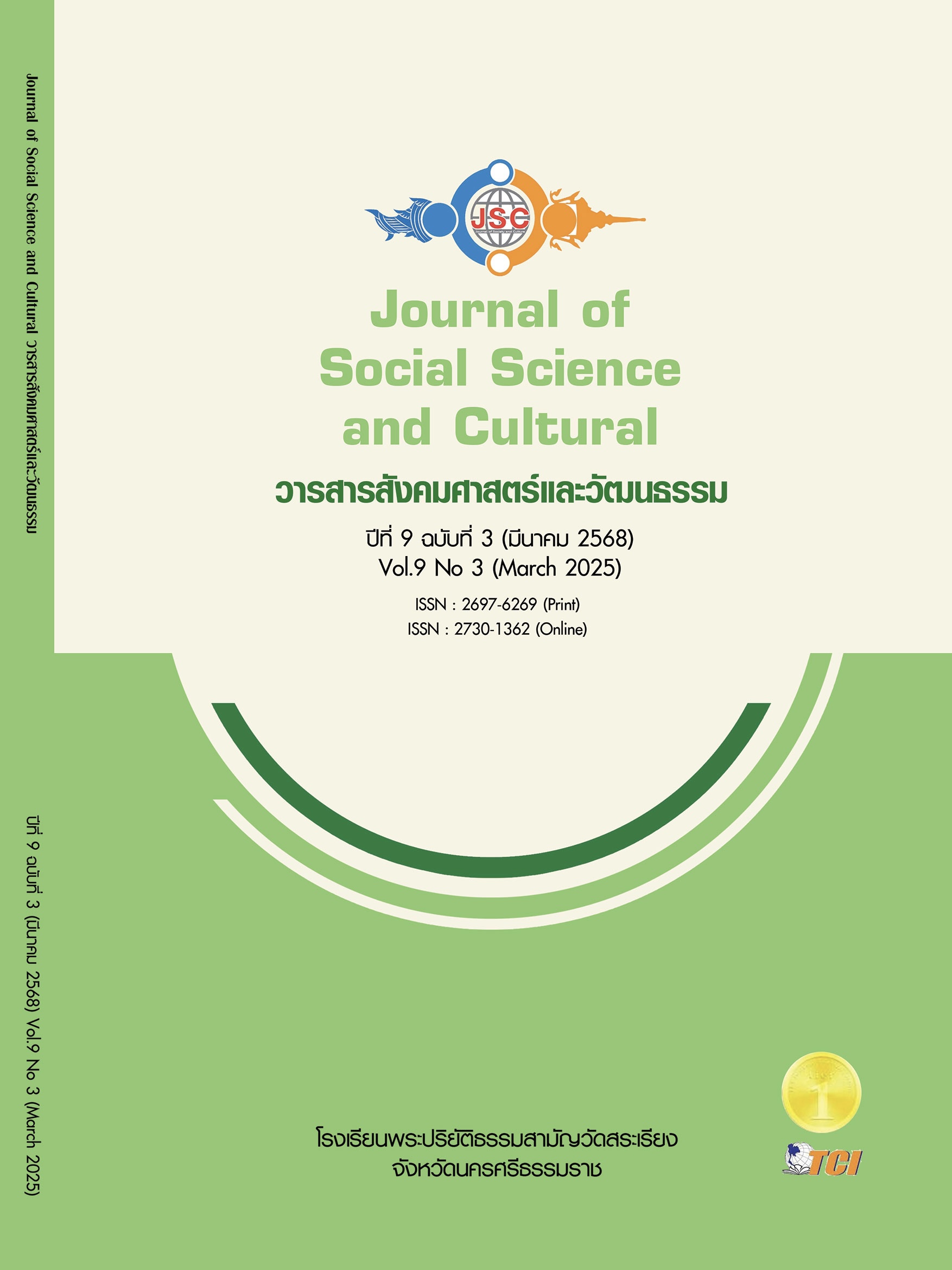THE POLICY COMPARATIVE STUDY OF ELECTRONIC CIGARETTES IN THE GROUP OF ASEAN COUNTRIES
Main Article Content
Abstract
This research aims to study: 1) The situation of e-cigarettes in ASEAN countries, 2) E-cigarette control policies in ASEAN countries, and 3) Compare e-cigarette control policies across ASEAN countries. The study employs qualitative research methods, specifically documentary research,
by analyzing survey reports and academic articles on e-cigarettes, policies, and measures to prevent e-cigarette use, as well as laws, regulations, and local online media providing information on the situation and policies in ASEAN countries. The research covers 10 ASEAN member states: Brunei, Cambodia, Indonesia, Laos, Malaysia, Myanmar, the Philippines, Singapore, Thailand, and Vietnam. The findings indicate that e-cigarette consumption is on the rise in nearly all ASEAN countries.
E-cigarette use is most prevalent among adolescents and working-age individuals, driven by the perception of e-cigarettes as an alternative to quitting traditional smoking and the appeal of the products. Male users significantly outnumber female users. Except in Singapore, where there is no notable prevalence, and the public demonstrates high awareness of e-cigarettes. E-cigarette control policies in ASEAN countries can be categorized into three groups: 1) Tobacco control laws that regulate public consumption and business operations related to e-cigarette sales.
2) Other tax-related laws, including customs and excise taxes, which regulate importers and distributors, allowing the sale of e-cigarettes provided taxes are paid in accordance with the law. and 3) Other laws, such as local laws, Islamic laws, or state-specific measures. Singapore stands out as the country with the most stringent legal measures, next is Cambodia. While Myanmar lacks e-cigarette-specific laws, resulting in a growing e-cigarette market and a high prevalence of young e-cigarette users. Meanwhile, Indonesia actively promotes its e-cigarette industry.
Article Details
References
กมลพร ยศนันท์. (2563). มาตรการทางกฎหมายในการควบคุมบุหรี่ไฟฟ้า. วารสารบัณฑิตศึกษานิติศาสตร์, 13(4), 443-457.
คำสั่งคณะกรรมการคุ้มครองผู้บริโภค. (2558). รื่อง ห้ามขายหรือห้ามให้บริการสินค้า “บารากู่ บารากู่ไฟฟ้าหรือบุหรี่ไฟฟ้า หรือตัวยาบารากู่ น้ำยาสำหรับเติมบารากู่ไฟฟ้าหรือบุหรี่ไฟฟ้า”. ราชกิจจานุเบกษา เล่ม 132 ตอนพิเศษ 39 ง หน้า 28-29 (18 กุมภาพันธ์ 2558) .
จัสมีน รึ้กก์. (2565). การจัดเก็บภาษีสรรพสามิตจากบุหรี่ไฟฟ้า. วารสารนิติ รัฐกิจ และสังคมศาสตร์, 6(1), 47-67.
เจาะลึกระบบสุขภาพ. (2565). ศจย. เผยผลวิจัยกว่า 7,000 ชิ้นยืนยันผลกระทบบุหรี่ไฟฟ้า. เรียกใช้เมื่อ 15 กุมภาพันธ์ 2568 จาก https://www.hfocus.org/content/2022/12/26661
ประกาศกระทรวงพาณิชย์. (2559). เรื่อง สินค้าต้องห้ามนำผ่านราชอาณาจักร พ.ศ. 2559. ราชกิจจานุเบกษา เล่ม 133 ตอนพิเศษ 40 ง หน้า 7-8 (11 กุมภาพันธ์ 2559).
พรทิพา สุวัฒภิญโญ และคณะ. (2564). ปัจจัยที่สัมพันธ์กับการสูบบุหรี่ไฟฟ้าของนักเรียนชั้นมัธยมศึกษาตอนปลายในเขตกรุงเทพมหานคร. วารสารสุขศึกษา, 44(2), 88-101.
พระราชบัญญัติควบคุมผลิตภัณฑ์ยาสูบ. (2560). ราชกิจจานุเบกษา เล่ม 134 ตอนที่ 39 ก หน้า 27-47 (4 เมษายน 2560) .
พระราชบัญญัติคุ้มครองผู้บริโภค (ฉบับที่ 4). (2562). ราชกิจจานุเบกษา เล่ม 136 ตอนที่ 69 ก หน้า 96-114 (27 พฤษภาคม 2562) .
พระราชบัญญัติศุลกากร. (2560). ราชกิจจานุเบกษา เล่ม 134 ตอนที่ 53 ก หน้า 75-75 (17 พฤษภาคม 2560).
ไพศาล ลิ้มสถิตย์ และจุมพล แดงสกุล. (2567). ประเด็นกฎหมายในการควบคุมบุหรี่ไฟฟ้าและกรณีศึกษาต่างประเทศ. วารสารนิติศาสตร์ มหาวิทยาลัยธรรมศาสตร์, 53(1), 178-213.
ภัณฑิรา ปริญญารักษ์ และคณะ. (2565). อิทธิพลของข้อมูลข่าวสารต่อพฤติกรรมและการตัดสินใจสูบบุหรี่ไฟฟ้า. วารสารควบคุมโรค, 48(3), 539-550.
สำนักงานสถิติแห่งชาติ. (2564). การสำรวจพฤติกรรมด้านสุขภาพของประชากร พ.ศ. 2564. เรียกใช้เมื่อ 20 มกราคม 2567 จาก https://www.trc.or.th/th/attachments/article/618/สถิติบุหรี่%202564.pdf
เอื้อมพร สุ่มมาตย์ และกิติพงษ์ เรือนเพ็ชร. (2565). ปัจจัยพยากรณ์การสูบบุหรี่ไฟฟ้าของนักเรียนชายอาชีวศึกษาจังหวัดบุรีรัมย์. วารสารมหาวิทยาลัยคริสเตียน, 28(2), 39-52.
Thai PBS. (2566). คนไทย สูบ “บุหรี่ไฟฟ้า” เกือบ 8 หมื่นคน พบกลุ่มเด็กเยาวชนเพิ่มขึ้น. เรียกใช้เมื่อ 13 มกราคม 2567 จาก https://www.thaipbs.or.th/news/content/328379
The Active. (2565). บ.บุหรี่ รุกหนักตลาดอาเซียน แนะคุมเข้ม สกัดเด็ก - เยาวชนจาก “บุหรี่ไฟฟ้า”. เรียกใช้เมื่อ 15 กุมภาพันธ์ 2568 จาก https://theactive.thaipbs.or.th/news/publichealth-20240514-2
wresearch. (2020). Philippines E-Cigarette Market (2020-2026) | Analysis, Growth, Companies, Value, Revenue, Industry, Share, Outlook, COVID-19 IMPACT, Size, Trends & Forecast. Retrieved January 20, 2024, from https://www.6wresearch.com/industry-report/philippines-e-cigarette-market-2020-2026
Federal Government Gazette. (2020). Excise Duties (Amendment) Order 2020. Retrieved January 18, 2024, from https://www.customs.gov.my/en/pg
Government Gazette. (2005). Tobacco Order. Retrieved December 22, 2023, from https://assets.tobaccocontrollaws.org/uploads/legislation/Brunei%20Darussalam/Brunei-Darussalam-TO-2005.pdf
IHSN Survey Catalog. (2019). Global Youth Tobacco Survey 2019. Retrieved January 18, 2024, from https://datacatalog.ihsn.org/catalog/12116
Jakartaglobe. (2023). Equally Bad as Regular Cigs: Gov't Told to Get Tough on Vapes. Retrieved August 1, 2023, from https://jakartaglobe.id/news/equally-bad-as-regular-cigs-govt-told-to-get-tough-on-vapes,
Le, H. T. T. et al. (2022). E-Cigarette Use among University Students from One University in Hanoi, Vietnam, and Associated Factors. Asian Pacific journal of cancer prevention: APJCP, 23(11), 3649-3655.
Lian, T. Y. & Dorotheo, U. (2021). The Tobacco Control Atlas: ASEAN Region, Fifth Edition. Retrieved December 22, 2023, from https://seatca.org/dmdocuments/SEATCA%20ASEAN%20Tobacco%20Control%20Atlas_5th%20Ed.pdf
Ling, M. Y. et al. (2023). Prevalence and Associated Factors of E-Cigarette Use among Adolescents in Southeast Asia: A Systematic Review. International journal of environmental research and public health, 20(5), 3883. https://doi.org/10.3390/ijerph20053883.
Maglalang, D. D. et al. (2023). Social Influence of E-cigarette Use among Asian Americans in California. American journal of health behavior, 47(1), 173-181.
Ministry of Health Singapore. (2020). Minimum legal age for smoking raised to 21 from Jan 1. Retrieved January 25, 2024, from https://www.moh.gov.sg/news-highlights/details/
minimum-legal-age-for-tobacco-raised-to-21-years-old-from-1-january-2021.
Nguyen, N. B. et al. (2020). Change in Compliance of Staff at 4 Vietnam Universities after the Enactment of Smoke-free Environment Decree. Environmental health insights, 14, 1-8 https://doi.org/10.1177/1178630220972957
Phạm Thanh Hữu. (2022). Điều kiện kinh doanh sản phẩm thuốc lá điện tử. Retrieved May 23, 2023, from https://thuvienphapluat.vn/chinh-sach-phap-luat-moi/vn/ho-tro-phap-luat/tu-van-phap-luat/39596/dieu-kien-kinh-doanh-san-pham-thuoc-la-dien-tu
Phyo, Y. et al. (2020). Prevalence of e-cigarette use among tobacco smokers in six states and regions of Myanmar. Addictive behaviors reports, 11, 1-5 https://doi.org/10.1016/j.abrep.2020.100248
Richard, J. W. et al. (2021). E-Cigarette Use and Adult Cigarette Smoking Cessation: A Meta-Analysis. Am J Public Health, 111(2), 230-246.
Schmid, T. (2022). Vape Stance Softens in Southeast Asia. Retrieved May 23, 2023, from https://www.tobaccoasia.com/features/vape-stance-softens-in-southeast-asia/.
Singapore Statutes. (2014). Tobacco (Control of Advertisements and Sale) (Prohibited Tobacco Products) Regulations 2014. Retrieved January 22, 2024, from https://sso.agc.gov.sg/SL/TCASA1993-S70-2018?DocDate=20180131
Song, Y. & Zhao, A. (2023). Into Indonesia. Retrieved May 23, 2023, from https://tobaccoreporter.com/2023/01/02/into-indonesia/
Tobacco Control Law (Laos PDR). (2021). Tobacco Control Law (Amended). Retrieved November 13, 2023, from https://assets.tobaccocontrollaws.org/uploads/legislation/Lao%20PDR/Lao-PDR-TC-Law-Amended.pdf
Tobacco Control Laws. (2023). Main Policies. Retrieved November 13, 2023, from https://www.tobaccocontrollaws.org/legislation/viet-nam/e-cigarettes/main-policies
World Health Organization. (2003). World Health Organization Framework Convention on Tobacco Control. Retrieved January 24, 2024, from https://iris.who.int/bitstream/handle/10665/42811/9241591013.pdf
World Health Organization. (2022). Oral Health Country Profile. Retrieved January 12, 2024, from https://cdn.who.int/media/docs/default-source/country-profiles/oral-health/oral-health-brn-2022-country-profile.pdf?sfvrsn=d96435cb_17
World Vapers Alliance. (2023). Vapeless Nation: Finding harm reduction products in Cambodia. Retrieved March 9, 2023, from https://worldvapersalliance.com/eu/vapeless-nation-finding-harm-reduction-products-in-cambodia/#:~:text=Cambodia%20.
Yusof, M. Z. (2021). Vaping on the rise in Singapore: Harder to thwart illicit trade as e-vaporisers are easier to hide. Retrieved January 25, 2024, from https://www.straitstimes.com/singapore/harder-to-thwart-illicit-trade-as-e-vaporisers-are-easier-to-hide-0

